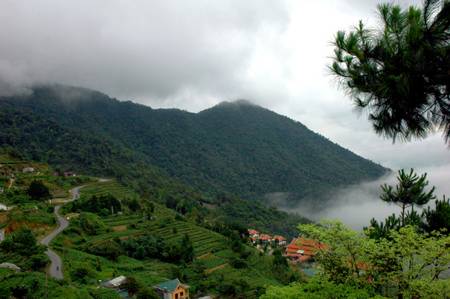VietnamSurprise – The Tam Dao National Park is located in Son Duong district, Tuyen Quang province, Dai Tu district, Thai Nguyen province, and Lap Thach, Tam Dao and Me Linh districts, Vinh Yen province.
The national park lies along a massif, which runs from north-west to southeast, and is isolated from other high-elevation areas by intervening areas of low elevation. There are several peaks over 1,300 m in the national park, the highest of which is Mount Tam Dao Bac at 1,592 m. The lowest point in the national park is c. 100 m.
The Tam Dao National Park lies within the catchment of two major rivers: the northeast face of the massif lies within the catchment of the Cong river, while the south-west face lies within the catchment of the Day river. Most of the streams and rivers in the national park are steep and fast flowing. Tam Dao experiences a tropical monsoon climate. The mean annual rainfall of around 2,800 mm is concentrated in the rainy season from April to October, when 90% of the total rainfall occur. During the dry season, rainfall and humidity at higher elevations can be very low, making these areas susceptible to forest fire.
Tam Dao supports 21,982 ha of natural forest and 1,351 ha of plantation forest. The natural forest is of two main types: lowland evergreen forest and lower Montane evergreen forest. The lowland evergreen forest is distributed at elevations between 700 and 800 m, and is heavily degraded. The diversity of tree species in this forest type is high, with the Fabaceae, Dipterocarpaceae, Meliaceae, Burseraceae, Myrtaceae and Anacardiaceae families being well represented. The lower Montane evergreen forest is distributed above 800 m. Members of the Dipterocarpaceae family are almost entirely absent from this forest type, which is dominated by species in the Fagaceae, Lauraceae, Magnoliaceae, Aceraceae, Theaceae, Hamamelidaceae, Sapotaceae and Ericaceae families. Also in this forest type, a number of conifer species are present, such as Decussocarpus fleuryi, Amentotaxus argotaenia, Podocarpus imbricatus and Fokienia hodginsii. In addition to the two main forest types, Tam Dao National Park supports 669 ha of elfin forest, dominated by species in the Ericaceae and Theaceae families.
Tam Dao National Park has been the focus of some of the highest levels of Herpetological survey effort in Vietnam, and a large number of reptile and amphibian species have been recorded there. A number of the amphibian species recorded at Tam Dao were assessed as globally threatened during the Global Amphibian Assessment, including Theloderma corticale, T. gordoni and Vietnamese Salamander Paramesotriton deloustali.
The Tam Dao National Park also supports some of the highest levels of recorded insect diversity in Vietnam.
Tam Dao National Park qualifies as an Important Bird Area because of its importance for the conservation of biome-restricted bird species. In particular, the site supports a number of biomes-restricted species that are known from a few other sites in Vietnam, such as Blue-naped Pitta Pitta nipalensis, Purple Cochoa Cochoa purpurea, Chestnut-headed Tesia Tesia castaneocoronata, Pale-footed Bush Warbler Cettia pallidipes and Greater Rufous-headed Parrotbill Paradoxornis ruficeps.
Tam Dao town, which lies within the boundaries of Tam Dao National Park, was originally developed as a hill station by the French colonialists in the early 20th century. In recent years, the town has been re-established as a site for tourism, and now receives thousands of domestic and foreign tourists each year.
Source: activetravelvietnam.com

